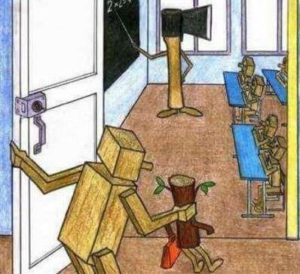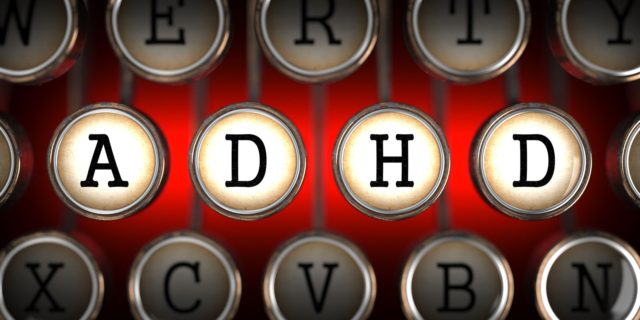 Some children are better at paying attention than others. Some can cope with, or even enjoy, a school classroom setting. Some kids have more energy than others. Some are good at following directions, and some are easily distracted.
Some children are better at paying attention than others. Some can cope with, or even enjoy, a school classroom setting. Some kids have more energy than others. Some are good at following directions, and some are easily distracted.
But just because a classroom is not a good environment for many children does not mean they have a disorder. They may have an Attention Deficit because they are bored. They may he Hyperactive because they are cooped up and forced to sit still at a desk. But this does not constitute a Disorder.
What happened to the belief in the uniqueness of a child? Aren’t they told they don’t have to fit in? And then if the factory school system doesn’t work for them, they have a disorder.
Instead of treating children like individuals, schools and parents act like they have no other choice but to let drugs make the behavioral adjustments. How sad that there is more willingness to drug kids to make them fit in, instead of changing the system, or being attentive to individual needs.
The Tragicomedy of ADHD An article about ADHD from Healthline would be funny if it weren’t tragic.
Who gets ADHD, a graphic asks? Children living below 2x the poverty line are at an increased risk. Boys are 3x more likely to be afflicted than girls. Children with mild ADHD are usually diagnosed at 8 years old, while children with severe ADHD are diagnosed at 5 years old.
Wow! What genius did this research? Boys run around more than girls? You can tell which kids have more energy at a younger age? Kids with a less stable upbringing are less well behaved? Somebody deserves a Nobel prize.
Girls symptoms are less obvious, the article says. To act withdrawn or have a tendency to daydream constitutes a disorder. Of course, this couldn’t have anything to do with the system! Surely being force-fed boring and irrelevant lessons couldn’t have anything to do with a tendency to daydream.
The American Psychiatric Association (APA) says 4% of children have ADHD, while the Centers for Disease Control (CDC) claims the number is closer to 11%.
Raise your hand if you’re surprised the government almost triples the estimate for ADHD affliction compared to a private organization.
But they say it’s not the government schooling system that needs to be changed, that’s out of the question! We just need to pump kids full of drugs to solve these problems. The children have the disorder, not the school system.
The two states with the highest instances of ADHD are Kentucky and Arkansas.
My first thought was that this proves that ADHD is a social construction. My biased brain immediately thinks: duh, kids in those states want to run around outside with their shoes off, catching crawfish and climbing trees. Not stuck in a classroom.
But I don’t want to just base this on stereotypes, so I did a little research.
According to census data, 86% of 6-15-year-old Kentuckians fish and 31% Hunt.
In Arkansas, 89% of 6-15-year-olds fish, and 35% hunt.
Who hunts and fishes by state was readily available information. These were the closest indicators I could think of that Kentucky and Arkansas children are more interested in being outside and active than cooped up in a classroom.
Compare that to the two states with the lowest instances of ADHD, Nevada and New Jersey. Both states did not produce enough data on 6-15-year-old hunters to give an accurate statistic. In Nevada, 44% of children 6-15 fish. 45% of New Jersey kids fish.
To me, this suggests that the states with the highest instances of ADHD diagnosis are also states where the traditional values of public education are least aligned with the population.
Children have different interests. Why do we need to fit everyone in the same “education” box, especially if it requires drugs? If kids’ brains are more attuned to fishing and hunting than chalkboards and composition, let them be!
There are all different ways to learn and make connections. But drugging kids up robs them of their creativity at an age when brains are still forming. This ensures they never reach their full potential.
Instead of letting them pursue their natural interests, they are forced into a mold. But since that mold comes unnaturally, they will never excel as much as their peers.
This sets them up for a life of “failure.” If the system just let them do their own thing, there is no telling what genius would be produced.
What An ADHD Diagnosis Does to a Kid’s Future
Some schools end up harassing parents who do not comply with their recommendations to drug their kids. Some parents are not well informed and take schools’ advice, wrongly assuming it is scientific.
…experts have voiced concerns that students are being diagnosed with ADHD simply as a matter of convenience. Children who display behaviors such as inattention, impulsivity and hyperactivity are often singled out for assessments. Some would say these are pretty typical behaviors for young people depending on their personality, but many public schools are quick to tell parents to bring their child to a psychiatrist for a diagnosis in the knowledge that the child will be far less disruptive once they’re medicated. It’s easier and faster than teaching them proper behavior, right?
A UCLA study found that kids with ADHD are more likely than the general population to abuse drugs in the future. But the rate of addiction was the same among children with ADHD who were prescribed medication versus those who were not. So it appears that the drugs themselves do not lead to future addiction if this study can be trusted.
But what if the ADHD diagnosis itself causes the future problems?
Kids are labeled at a young age as having a disorder. They are treated differently by teachers, peers, and even parents. They may develop social isolation from this. And as we discussed the other day, isolation is the main contributor to drug addiction.
So perfectly normal kids are having their lives ruined by a diagnosis of a fake disorder. It is only real in the sense that it is a social disorder. And I would say not fitting into the current public school system is an asset, not a disorder.
Related ~ MORE on ADHD…
Written by Joe Jarvis and published by The Daily Bell ~ February 1, 2018.
 FAIR USE NOTICE: This site contains copyrighted material the use of which has not always been specifically authorized by the copyright owner. We are making such material available in our efforts to advance understanding of environmental, political, human rights, economic, democracy, scientific, and social justice issues, etc. We believe this constitutes a ‘fair use’ of any such copyrighted material as provided for in section 107 of the US Copyright Law. In accordance with Title 17 U. S. C. Section 107, the material on this site is distributed without profit to those who have expressed a prior interest in receiving the included information for research and educational purposes. For more information go to: http://www.law.cornell.edu/uscode/17/107.shtml“
FAIR USE NOTICE: This site contains copyrighted material the use of which has not always been specifically authorized by the copyright owner. We are making such material available in our efforts to advance understanding of environmental, political, human rights, economic, democracy, scientific, and social justice issues, etc. We believe this constitutes a ‘fair use’ of any such copyrighted material as provided for in section 107 of the US Copyright Law. In accordance with Title 17 U. S. C. Section 107, the material on this site is distributed without profit to those who have expressed a prior interest in receiving the included information for research and educational purposes. For more information go to: http://www.law.cornell.edu/uscode/17/107.shtml“
